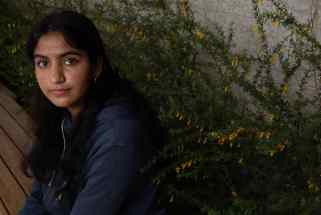A road to reconciliation Archbishop says decision to take residential school proponent's name off Winnipeg street should belong to Indigenous community
Read this article for free:
or
Already have an account? Log in here »
To continue reading, please subscribe:
Monthly Digital Subscription
$0 for the first 4 weeks*
- Enjoy unlimited reading on winnipegfreepress.com
- Read the E-Edition, our digital replica newspaper
- Access News Break, our award-winning app
- Play interactive puzzles
*No charge for 4 weeks then price increases to the regular rate of $19.00 plus GST every four weeks. Offer available to new and qualified returning subscribers only. Cancel any time.
Monthly Digital Subscription
$4.75/week*
- Enjoy unlimited reading on winnipegfreepress.com
- Read the E-Edition, our digital replica newspaper
- Access News Break, our award-winning app
- Play interactive puzzles
*Billed as $19 plus GST every four weeks. Cancel any time.
To continue reading, please subscribe:
Add Free Press access to your Brandon Sun subscription for only an additional
$1 for the first 4 weeks*
*Your next subscription payment will increase by $1.00 and you will be charged $16.99 plus GST for four weeks. After four weeks, your payment will increase to $23.99 plus GST every four weeks.
Read unlimited articles for free today:
or
Already have an account? Log in here »
Hey there, time traveller!
This article was published 02/06/2021 (1649 days ago), so information in it may no longer be current.
The Roman Catholic Archbishop of St. Boniface won’t object if the name of a former bishop from the same diocese is removed from a well-travelled south Winnipeg thoroughfare.
As long as that’s what Indigenous people want for Bishop Grandin Boulevard.
“Theirs is the voice that should carry the greatest weight in making this decision,” Archbishop Albert LeGatt told the Free Press Wednesday, adding it is not his place to make that call, deferring to Indigenous organizations to request the name change.
Some Winnipeggers have suggested renaming the road named after Bishop Vital-Justin Grandin, an Oblate priest who serve as coadjutor bishop to Bishop Alexandre-Antonin Taché of St. Boniface from 1869 to 1871.
In 1871, Grandin was named the bishop of the newly created Diocese of St. Albert, near Edmonton. He died in Alberta on June 3, 1902.
While in Alberta, Grandin advocated for the building of three industrial schools for Indigenous children, viewing the residential facilities as a way to “civilize” and evangelize Indigenous children.
“We instil in them a pronounced distaste for the native life so that they will be humiliated when reminded of their origins,” he wrote in 1875 about residential schools.
“When they graduate from our institutions, the children have lost everything Native except their blood.”
St. Vital and Rue Grandin in north St. Boniface also bear the French-born bishop’s name. Métis settlers originally wanted to name their new parish after Taché’s patron saint, but he suggested it be named after Vitalis of Milan, Italy, the patron saint of Grandin.
Memorials honour children
Moved by the plight of 215 Indigenous children buried in an unmarked grave in B.C., St. Boniface resident Janelle Delorme set up a memorial at her church.
“I did it as a community member who really needed to do something,” Delorme said, adding she had permission from St. Boniface Roman Catholic Cathedral.
Moved by the plight of 215 Indigenous children buried in an unmarked grave in B.C., St. Boniface resident Janelle Delorme set up a memorial at her church.
“I did it as a community member who really needed to do something,” Delorme said, adding she had permission from St. Boniface Roman Catholic Cathedral.
“Yes, it’s a gesture, but we need to have a public showing to make people more aware of this.”
Now on maternity leave from Development and Peace, an international Catholic organization, Delorme saw other memorials honouring the Kamloops children and felt compelled to build one in her neighbourhood.
On Monday, she and six friends tied long, orange fabric ribbons to 215 metre-high bamboo garden sticks and installed them on the interlocking brick walkway stretching from Taché Avenue to the front steps of the stone ruins of the former cathedral. The current church is located at the back of the ruins.
During the installation, the group smudged every ribbon and placed a votive candle at the foot of each stick, inviting people to light them as they pay their respects.
“I actually don’t have the word to express this level of sorrow,” said Delorme, a mother of two young children who describes herself as Roman Catholic and Red River Métis.
“We, as Catholics, need to hold our church accountable.”
Archbishop Albert LeGatt planned to visit the memorial yesterday, and said he was happy to see it there as an expression of asking for forgiveness and acknowledging “the deep, deep hurt on the deaths of these children.”
Another memorial sprung up across the city at the offices of the Archdiocese of Winnipeg on Pembina Highway. On Tuesday morning, staff arrived to find dozens of children’s shoes, including tiny white sandals, black leather moccasins and pink rubber boots lining the walkway and front stairs of their two-storey building.
Four hand-lettered poster board signs were duct-taped to the exterior wall facing Pembina Highway, with another at the front door of the building, calling for apologies and restitution, and a request to have the shoes remain there for 24 hours.
Archbishop Richard Gagnon said diocesan staff removed the signs but left the shoes, orange ribbons and orange flowers.
“I have no problem with people expressing their grief over residential schools,” said Gagnon, who issued a statement Monday expressing sorrow over the discovery of the children’s bodies in an unmarked grave at the former Kamloops residential school.
Gagnon also signed a similar letter in his role as president of the Canadian Conference of Catholic Bishops.
“As we see ever more clearly the pain and suffering of the past, the Bishops of Canada pledge to continue walking side by side with Indigenous Peoples in the present, seeking greater healing and reconciliation for the future,” it said.
Reconciliation is a long process that needs to occur at many levels and institutions, he said.
“Space is necessary for dialogue, space is necessary for honesty and space is necessary for reflection,” he said.
— Brenda Suderman
On Monday, Mayor Brian Bowman posted on Twitter that it was time to “revisit the street name, Bishop Grandin” as an act of reconciliation.
LeGatt said the mayor’s office and the archdiocese have not discussed the matter.
Grand Chief Garrison Settee of Manitoba Keewatinowi Okimakanak Inc. has written to Bowman, urging him to select a new name for the boulevard because streets and schools named after people who harmed Indigenous people are a source of pain to his community.
“I would like to suggest that if we are to honour any person by naming a street after them, it would be a good step on the path of reconciliation to consider choosing an Indigenous person,” Settee wrote.
An online petition at change.org calling for renaming the street in consultation with survivors, Indigenous leaders and others in the community had collected more than 10,000 signatures by Wednesday afternoon.
LeGatt said Grandin was a 19th-century man who reflected the attitudes and beliefs of his time, and people in the 21st century have a responsibility to learn from the mistakes and systemic racism of the past and work toward reconciliation.
“The question is broader than just, ‘Should we take the name off the street?’ and broader than, ‘What did this man do?’ and, even if his interests were good, the results were horrific,” said LeGatt, who lives and works in the same building where Grandin was based.
“When someone has hurt or wounded someone, they’re not the ones to say what healing would look like. We’re called to be partners in that walk.”
brenda@suderman.com
The Free Press is committed to covering faith in Manitoba. If you appreciate that coverage, help us do more! Your contribution of $10, $25 or more will allow us to deepen our reporting about faith in the province. Thanks! BECOME A FAITH JOURNALISM SUPPORTER

Brenda Suderman has been a columnist in the Saturday paper since 2000, first writing about family entertainment, and about faith and religion since 2006.
Our newsroom depends on a growing audience of readers to power our journalism. If you are not a paid reader, please consider becoming a subscriber.
Our newsroom depends on its audience of readers to power our journalism. Thank you for your support.
The Free Press acknowledges the financial support it receives from members of the city’s faith community, which makes our coverage of religion possible.










.jpg?h=215)